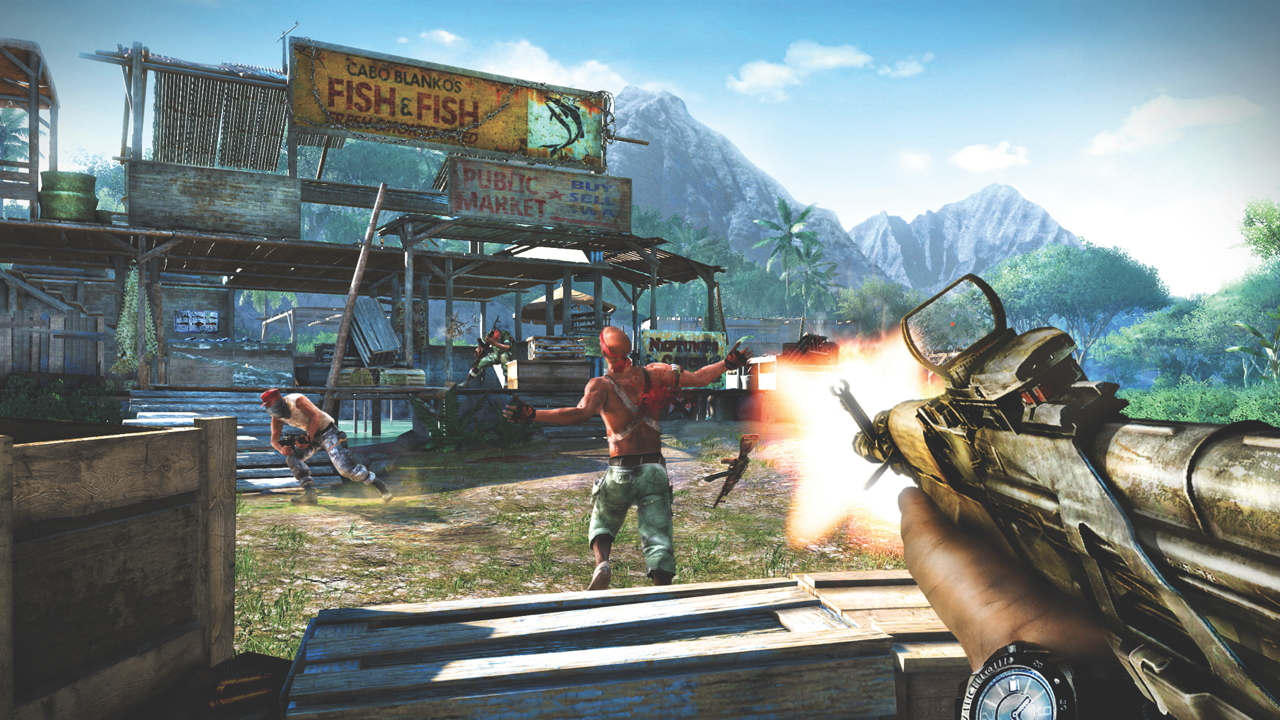How Far Cry 3 made the series what it is today

Now that the franchise has ascended to blockbuster status, it’s easy to forget that Far Cry was once a series in search of a stable identity. While the 2004 original may have featured the familiar blend of first-person shooting and lush locales, it was a PC exclusive comprising a series of discrete levels. Crytek’s debut was the seed for what Far Cry would become, but it was Ubisoft’s patented mulch that made the franchise what it is today.
And Far Cry 3 was the game that brought together the fragmented strands of the series’ DNA – accessible but adaptive action gameplay, an exotic open world and streamlined role-playing progression – into one coherent whole. The addition of an icon-packed map (uncovered by discovering radio towers, naturally) made Far Cry 3 a natural complement to the other open-world projects Ubisoft was developing at the time.

But if the game is a product of its time, the number of ways in which Far Cry 3’s many systems can rub up against one another remains surprising and delightful, even five years on. I start up one session by hopping into a rebel jalopy, and promptly gun it towards my objective marker. Within seconds, I realise with a certain sense of anxiety that a jeep full of piratical meanies is hurtling down the trail towards me. Panic-stricken, I yank the wheel, scraping the hostile 4x4 in the process. As I accelerate away, I’m braced for incoming gunfire, but none materialises. Instead, I hear pirate screams followed by a sonorous explosion. With some trepidation I pull over, and look back.
A huge inferno greets me, with a charred wreck of a jeep at its centre and two deer cadavers at its edge. Eventually, after much head-scratching and chin-stroking (I even made a rudimentary chart), I realise that my attempts to muscle past the enemy motor caused the pirates to lose control and careen off the cliff edge, where their rickety vehicle exploded into a villain-packed fireball. That’s when Far Cry 3’s dynamic fire propagation system must have kicked in, causing the blaze to spread from the charred car to the dried grass nearby. As for the deer, I suppose they were trapped between the encroaching blaze and the water’s edge. Bambi and his pal never stood a chance.

This kind of cold-hearted animal butchery isn’t just relegated to car crashes, though. Another open-world innovation that Far Cry 3 brought to the table was its streamlined crafting system, which requires you to hunt and skin specific animals in order to stitch together an expanded grenade pouch, for instance, or a crocodile-skin pack full of flamethrower fuel. It’s sandbox busywork, yes, but the pursuit of tropical fauna – from the humble deer to the terrifying cassowary – is too exotic and grisly to be boring. Could anyone really describe the process of shovelling harvested boar flesh into a backpack as dull? I rest my case.
Early on in the game, I pin my greedy, beady eyes on an expanded munitions pouch, and soon discover that it requires two goat pelts to craft (two entire goat pelts?! What munition is the size of two hollowed-out goats?). I creep through tropical foliage towards Rook Island’s premiere hircine meeting point. And what do I find there? Zip. After searching high and low to no avail, I leave the clearing in low spirits having been outsmarted by a bunch of ruminant jerks. And that’s when I stumble across a cliffside ledge that’s positively crawling with cloven-footed quarry.

But without a silenced weapon, I’m unsure as to how best to proceed. Goats are hardy creatures, after all, and by the time I riddle one of them with lead, the others are sure to have trotted away to safety. Slowly, a plan forms. I crouch to mask my footsteps, and begin rummaging through my crappy non-goatskin munitions pouch for a grenade. I take aim, pop the pin, and wait. After three tense seconds, I hurl the explosive towards my prey, where it explodes before even hitting the ground. All three goats are dead, and I’m left to dance the gore-soaked dance of the winner as I procure their precious pelts.
Weekly digests, tales from the communities you love, and more
Now that I’m suitably upgraded, I feel more comfortable taking the fight to Vaas and his buccaneer cronies once again, so I plot a course for the nearest enemy stronghold in an effort to loosen his grip on the region. Thanks to a generous takedown range and plenty of natural cover, I’m able to machete my way through the compound’s guards in relatively short order, banking a hefty XP bonus for my stealthy shenanigans in the process.

My next stronghold assault, however, doesn’t even require me to unsheathe my blade. Confronted with a heavily-guarded compound packed with enemy heavies, I decide to carefully survey the perimeter of the camp before dashing in willy-nilly. And that’s when I spot a muscular tiger, sunning itself in a nearby patch of grass. The opportunity is too perfect to pass up. I hurl a stone near the sunbathing brute and he lazily sits up, looks towards the disturbance then moves to investigate.
Seven stones later, and I’ve led the tiger to the stronghold gates. And that’s when the shooting begins. The panicking guards unload round after round into this fearsome beast, but it only serves to enrage the feisty feline, which proceeds to dash through the camp chomping merrily on privateer oesophagus. By the time Vaas’ men bring down my killer kitty, the stronghold population has dropped from a dozen or more to just two, and they’re absolutely cacking themselves. I move in and mop up.

These are the organic stories that made Far Cry 3 such a memorable experience five years ago, creating the sense of a believable world in which things happened and people acted independently of your actions as protagonist. Pirates would crash their cars. Tigers would attack indiscriminately. And ratatat gunfire would echo through the jungle, suggesting a far-off battle you could join or ignore as you chose. And if Far Cry 3 made the series what it is today, here’s hoping Far Cry 5 can breathe new life into the franchise all over again.
This article originally appeared in Xbox: The Official Magazine. For more great Xbox coverage, you can subscribe here.
James has been writing about games for more than a decade, covering everything from glittering masterpieces to PlayStation Home. Over the years, he's contributed to the likes of OXM, OPM, and GamesMaster, though he occasionally finds time to write for publications that don't get closed down, too. And although he was once Managing Editor of Warhammer Community, he actually prefers knitwear to ceramite.



